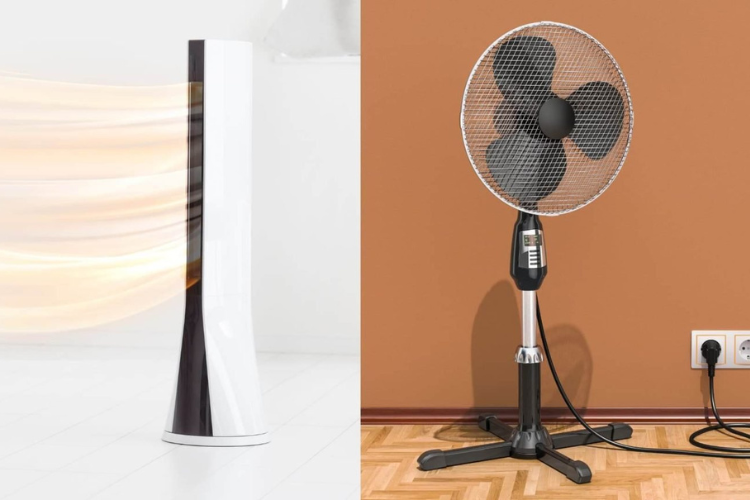When it comes to keeping your home cool and comfortable, two common options stand out: the tower fan and the pedestal fan. Each fan type offers unique benefits, and choosing the right one depends on your specific cooling needs, space, and personal preferences. In this article, we’ll explore the differences between 32-inch tower fan and pedestal fans, breaking down their features, performance, and ideal usage scenarios.
Tower Fan vs Pedestal Fan: Overview
Tower Fan
Tower fans are sleek, vertical devices that usually stand at about 3 to 4 feet tall. They are designed to be space-efficient and offer a modern aesthetic that blends well with contemporary interiors. Their slim, upright form allows them to fit into tight spaces, making them ideal for rooms with limited floor space.
Pedestal Fan
Pedestal fans, on the other hand, consist of a fan head mounted on a tall, adjustable stand. They tend to be bulkier but provide more flexibility in terms of height adjustment and directional airflow. Pedestal fans are typically more powerful, capable of producing stronger air circulation compared to tower fans.
Design and Aesthetics
Tower Fan Design
One of the main attractions of tower fans is their modern and minimalistic design. With a slim profile, tower fans can fit snugly in corners, next to furniture, or even in smaller rooms like bedrooms and offices. Their stylish appearance often features smooth, clean lines that complement modern decor. Many tower fans also come with touch controls, remote control capabilities, and digital displays, enhancing their appeal.
Pedestal Fan Design
While pedestal fans are less about aesthetics, they do have a functional design. The fan head is mounted on an adjustable pole, which allows for height and angle adjustments to suit the user’s needs. Pedestal fans are available in various sizes and colors, but their design is usually more traditional. They may not blend as seamlessly with modern interiors as tower fans, but their flexibility and range of airflow compensate for the less sleek appearance.
Airflow and Cooling Efficiency
Tower Fan Airflow
Tower fans use a vertical design that allows them to distribute air over a wide area. They typically feature a rotating base or oscillation mechanism that helps spread the airflow evenly throughout the room. While tower fans may not offer as intense airflow as pedestal fans, they are quieter and can provide a gentle breeze, which is ideal for smaller spaces or for those who prefer subtle cooling.
Pedestal Fan Airflow
Pedestal fans excel in airflow power. The large fan blades and adjustable height allow them to cover a broader area, making them more suitable for larger rooms or areas that require stronger air circulation. Pedestal fans often have a higher cubic feet per minute (CFM) airflow rate than tower fans, meaning they can move more air in less time. This makes them a great choice for people who need fast, powerful cooling, such as in living rooms or open spaces.
Noise Levels
Tower Fan Noise
One of the significant advantages of tower fans is their quiet operation. Thanks to their compact, bladeless design, many tower fans are engineered to produce minimal noise, even at higher speeds. This makes them an excellent choice for bedrooms, offices, or other areas where quiet is essential.
Pedestal Fan Noise
Due to their larger blades and higher airflow output, pedestal fans tend to be noisier than tower fans. While modern pedestal fans may have noise-reduction features, they typically generate more sound when operating at full power. If you plan to use a fan in a bedroom or quiet workspace, the noise from a pedestal fan might be distracting.
Space and Portability
Tower Fan Space Efficiency
Tower fans are ideal for those with limited space. Their slim and tall design means they can be tucked into corners or placed beside furniture without taking up much floor space. This is a major advantage for people living in apartments or smaller homes where every square foot counts.
Pedestal Fan Space Efficiency
Pedestal fans require more space due to their wide base and adjustable stand. While they provide excellent airflow, they may not be the best choice for small rooms or spaces where floor space is at a premium. However, pedestal fans are relatively lightweight and portable, making it easy to move them between rooms as needed.
Features and Technology
Tower Fan Features
Tower fans are often equipped with advanced features such as remote controls, timers, and programmable settings. Many models offer multiple speed settings, oscillation options, and even air purifying functions. Some tower fans come with built-in ionizers or HEPA filters, which can help improve indoor air quality by capturing dust, allergens, and other particles.
Pedestal Fan Features
Pedestal fans also come with useful features, such as adjustable speed settings, oscillation, and tilt control. However, they generally have fewer technological features compared to tower fans. While some models may include remote controls or timers, pedestal fans are usually more straightforward in design, focusing primarily on delivering powerful airflow.
Energy Efficiency
Tower Fan Energy Use
Tower fans tend to be more energy-efficient than pedestal fans due to their smaller motors and lower power consumption. This makes them a good option for people looking to reduce energy costs or those who want to keep their fan running for extended periods without significantly increasing their electricity bill.
Pedestal Fan Energy Use
Pedestal fans, while effective at cooling larger spaces, usually consume more power due to their larger motor and higher airflow capacity. If you’re looking for a fan that can cool down a room quickly but without running it continuously, a pedestal fan could still be an efficient choice despite the higher energy consumption.
Price Comparison
Tower Fan Pricing
Tower fans tend to be more expensive than pedestal fans, primarily because of their sleek design, advanced features, and energy-efficient operation. The price of a tower fan can range from $50 to over $200, depending on the brand and additional features such as air filtration or smart connectivity.
Pedestal Fan Pricing
Pedestal fans are generally more affordable than tower fans, with prices ranging from $30 to $100. Although they may lack some of the high-tech features found in tower fans, pedestal fans offer excellent value for money, especially for those in need of powerful cooling on a budget.
Which One is Right for You?
Choosing between a tower fan and a pedestal fan ultimately depends on your specific needs:
- If you need strong, powerful airflow and have ample space: The pedestal fan is likely the better choice.
- If you prefer a quieter, more compact solution with additional features: A tower fan might suit your needs better.
For those seeking a modern look, tower fans offer a sleeker, space-saving design with advanced features. Pedestal fans, on the other hand, provide superior airflow power and flexibility, making them ideal for larger rooms or when rapid cooling is necessary.
Conclusion
Both tower fans and pedestal fans have their unique strengths and weaknesses. Tower fans are quieter, more space-efficient, and often packed with features, making them perfect for smaller spaces or areas where aesthetics and functionality matter. Pedestal fans, with their stronger airflow and flexibility, are excellent for larger rooms or when quick, powerful cooling is required. Ultimately, the right choice comes down to your personal preferences, room size, and cooling needs.




